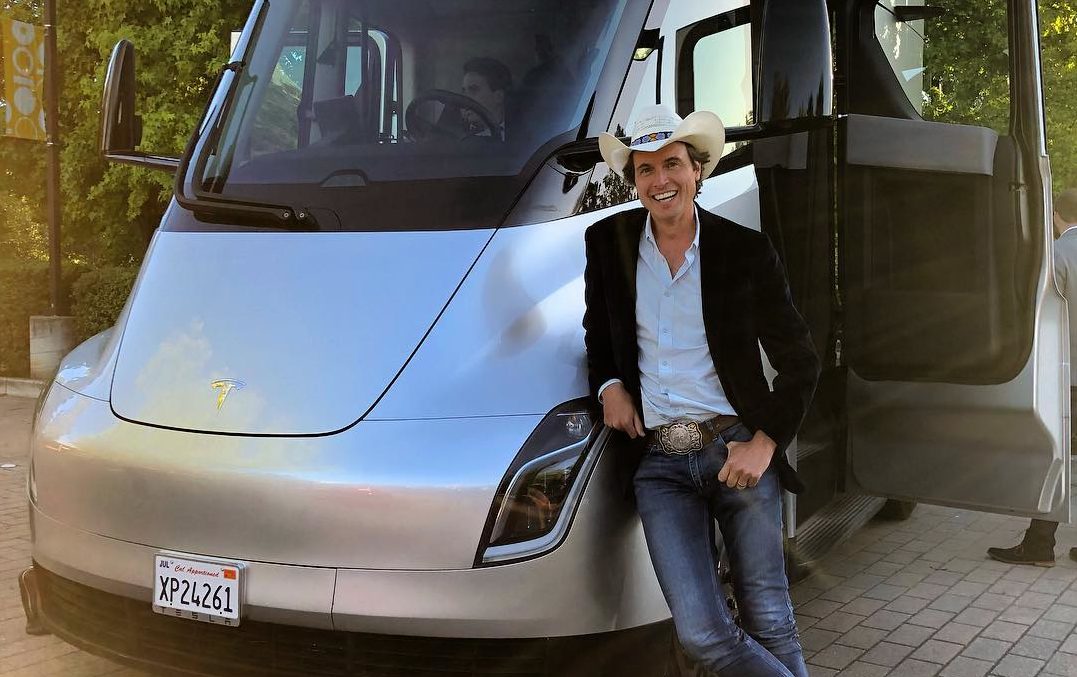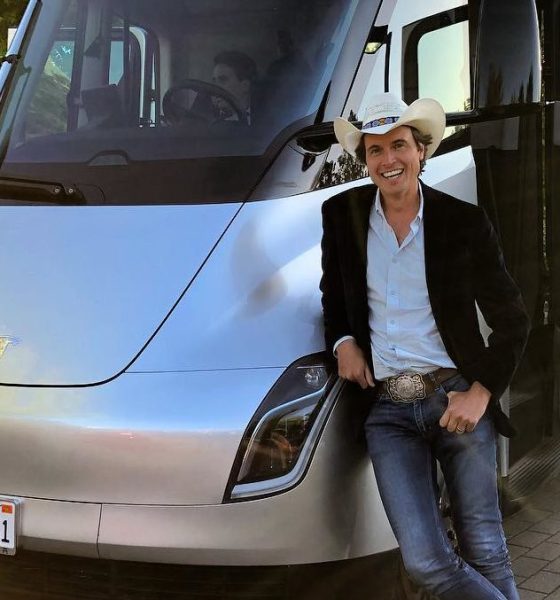

News
Tesla’s ‘Big Green’ Semi truck gets a shoutout from Kimbal Musk
The Tesla Semi recently got a shoutout from someone who is part of Elon Musk’s most intimate circle — Kimbal Musk. In a recent post on his Instagram page, Kimbal dubbed the electric long-hauler as a “Big Green” Tesla Semi, referencing his nonprofit organization aimed at building Learning Gardens for schools across the United States.
Quite interestingly, Kimbal Musk’s projects, such as Big Green and Square Roots, could benefit from using the Tesla Semi. Big Green, for one, is involved with building interactive, modular gardens where young American students can learn about real food and healthy eating habits. Considering Kimbal Musk’s goal of building 100,000 Learning Gardens across the US, having an electric truck that can haul materials would be a good idea.
The Tesla Semi is also a perfect match for Kimbal’s Square Roots farming project. Square Roots involves converting old shipping crates into advanced, climate-controlled indoor farms that can yield more than 50 pounds of organic, non-GMO, pesticide-free greens each week. So far, Square Roots is only operating its shipping container-farms in Brooklyn, NY, but it’s not too difficult to see a future where the farming startup’s indoor farms can be transported and set up in other key US cities.
https://www.instagram.com/p/Bj4v7w4Apa6/?taken-by=kimbalmusk
Since being unveiled last November, the Tesla Semi has been sighted numerous times across the United States. Back in March, Elon Musk announced in his social media pages that Tesla would start using the all-electric trucks as transport vehicles to haul battery packs from Gigafactory 1 in Sparks, NV to the Fremont factory in CA. The two Tesla Semi prototypes have also been spotted conducting transport runs between Tesla’s headquarters in Palo Alto, CA and Fremont.
During its unveiling back in November, Elon Musk outlined several of the Semi’s impressive specs. Just like Tesla’s other vehicles, the Semi is capable of quick acceleration, thanks to its four Model 3-derived electric motors that produce instant torque. From a dead stop, the Semi is capable of sprinting from 0-60 mph in just 5 seconds, compared to about 15 seconds on a similar Class 8 diesel truck. With a full 80,000-pound load, the Semi can hit 60 mph in 20 seconds. On average, diesel-powered Class 8 trailers hit highway speeds in about a minute.
The Tesla Semi is capable of climbing 5% grades at a steady 65 mph, unlike diesel trucks that max out at 45 mph on 5% grades. Lastly, thanks to an upcoming network of Megachargers, the Semi will be capable of charging up to 400 miles of range in just 30 minutes.

The interior of the Tesla Semi as spotted during the 2018 Annual Shareholder Meeting. [Credit: TeslaModel11/Reddit]
During Tesla’s Q1 2018 earnings call, both Elon Musk and CTO JB Straubel noted that the production version of the Semi’s long-range variant would likely have almost 600 miles of range per charge. These statements, of course, stand in stark contrast to criticisms from Tesla’s competitors, especially Daimler AG head of trucks Martin Daum, who threw shade at Tesla earlier this year by suggesting that the Semi’s rated specs, if accurate, defy the laws of physics. According to Straubel, much of competitors’ criticisms come from a misunderstanding of Tesla’s battery technology.
“There’s a fundamental misunderstanding, I think, of what the current technology in our existing products can actually do. Maybe that’s just a misunderstanding of the current status of the technology versus others in the industry. If they’re benchmarking sort of the best battery pack they can buy from a supplier, and then mapping that with what the Semi could do, it doesn’t solve,” Straubel said.
While Tesla is not actively pushing sales for the Semi, Straubel noted during the first-quarter earnings call that the all-electric long-hauler has roughly 2,000 reservations to date. Production of the Tesla Semi is expected to begin in 2019.

News
Tesla FSD fleet is nearing 7 billion total miles, including 2.5 billion city miles
As can be seen on Tesla’s official FSD webpage, vehicles equipped with the system have now navigated over 6.99 billion miles.

Tesla’s Full Self-Driving (Supervised) fleet is closing in on almost 7 billion total miles driven, as per data posted by the company on its official FSD webpage.
These figures hint at the massive scale of data fueling Tesla’s rapid FSD improvements, which have been quite notable as of late.
FSD mileage milestones
As can be seen on Tesla’s official FSD webpage, vehicles equipped with the system have now navigated over 6.99 billion miles. Tesla owner and avid FSD tester Whole Mars Catalog also shared a screenshot indicating that from the nearly 7 billion miles traveled by the FSD fleet, more than 2.5 billion miles were driven inside cities.
City miles are particularly valuable for complex urban scenarios like unprotected turns, pedestrian interactions, and traffic lights. This is also the difference-maker for FSD, as only complex solutions, such as Waymo’s self-driving taxis, operate similarly on inner-city streets. And even then, incidents such as the San Francisco blackouts have proven challenging for sensor-rich vehicles like Waymos.
Tesla’s data edge
Tesla has a number of advantages in the autonomous vehicle sector, one of which is the size of its fleet and the number of vehicles training FSD on real-world roads. Tesla’s nearly 7 billion FSD miles then allow the company to roll out updates that make its vehicles behave like they are being driven by experienced drivers, even if they are operating on their own.
So notable are Tesla’s improvements to FSD that NVIDIA Director of Robotics Jim Fan, after experiencing FSD v14, noted that the system is the first AI that passes what he described as a “Physical Turing Test.”
“Despite knowing exactly how robot learning works, I still find it magical watching the steering wheel turn by itself. First it feels surreal, next it becomes routine. Then, like the smartphone, taking it away actively hurts. This is how humanity gets rewired and glued to god-like technologies,” Fan wrote in a post on X.
News
Tesla starts showing how FSD will change lives in Europe
Local officials tested the system on narrow country roads and were impressed by FSD’s smooth, human-like driving, with some calling the service a game-changer for everyday life in areas that are far from urban centers.

Tesla has launched Europe’s first public shuttle service using Full Self-Driving (Supervised) in the rural Eifelkreis Bitburg-Prüm region of Germany, demonstrating how the technology can restore independence and mobility for people who struggle with limited transport options.
Local officials tested the system on narrow country roads and were impressed by FSD’s smooth, human-like driving, with some calling the service a game-changer for everyday life in areas that are far from urban centers.
Officials see real impact on rural residents
Arzfeld Mayor Johannes Kuhl and District Administrator Andreas Kruppert personally tested the Tesla shuttle service. This allowed them to see just how well FSD navigated winding lanes and rural roads confidently. Kruppert said, “Autonomous driving sounds like science fiction to many, but we simply see here that it works totally well in rural regions too.” Kuhl, for his part, also noted that FSD “feels like a very experienced driver.”
The pilot complements the area’s “Citizen Bus” program, which provides on-demand rides for elderly residents who can no longer drive themselves. Tesla Europe shared a video of a demonstration of the service, highlighting how FSD gives people their freedom back, even in places where public transport is not as prevalent.
What the Ministry for Economic Affairs and Transport says
Rhineland-Palatinate’s Minister Daniela Schmitt supported the project, praising the collaboration that made this “first of its kind in Europe” possible. As per the ministry, the rural rollout for the service shows FSD’s potential beyond major cities, and it delivers tangible benefits like grocery runs, doctor visits, and social connections for isolated residents.
“Reliable and flexible mobility is especially vital in rural areas. With the launch of a shuttle service using self-driving vehicles (FSD supervised) by Tesla in the Eifelkreis Bitburg-Prüm, an innovative pilot project is now getting underway that complements local community bus services. It is the first project of its kind in Europe.
“The result is a real gain for rural mobility: greater accessibility, more flexibility and tangible benefits for everyday life. A strong signal for innovation, cooperation and future-oriented mobility beyond urban centers,” the ministry wrote in a LinkedIn post.
News
Tesla China quietly posts Robotaxi-related job listing
Tesla China is currently seeking a Low Voltage Electrical Engineer to work on circuit board design for the company’s autonomous vehicles.

Tesla has posted a new job listing in Shanghai explicitly tied to its Robotaxi program, fueling speculation that the company is preparing to launch its dedicated autonomous ride-hailing service in China.
As noted in the listing, Tesla China is currently seeking a Low Voltage Electrical Engineer to work on circuit board design for the company’s autonomous vehicles.
Robotaxi-specific role
The listing, which was shared on social media platform X by industry watcher @tslaming, suggested that Tesla China is looking to fill the role urgently. The job listing itself specifically mentions that the person hired for the role will be working on the Low Voltage Hardware team, which would design the circuit boards that would serve as the nervous system of the Robotaxi.
Key tasks for the role, as indicated in the job listing, include collaboration with PCB layout, firmware, mechanical, program management, and validation teams, among other responsibilities. The role is based in Shanghai.
China Robotaxi launch
China represents a massive potential market for robotaxis, with its dense urban centers and supportive policies in select cities. Tesla has limited permission to roll out FSD in the country, though despite this, its vehicles have been hailed as among the best in the market when it comes to autonomous features. So far, at least, it appears that China supports Tesla’s FSD and Robotaxi rollout.
This was hinted at in November, when Tesla brought the Cybercab to the 8th China International Import Expo (CIIE) in Shanghai, marking the first time that the autonomous two-seater was brought to the Asia-Pacific region. The vehicle, despite not having a release date in China, received a significant amount of interest among the event’s attendees.








